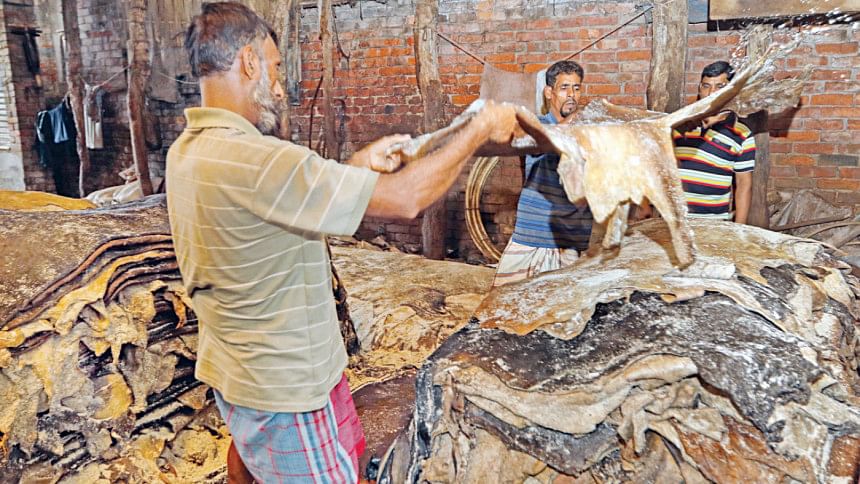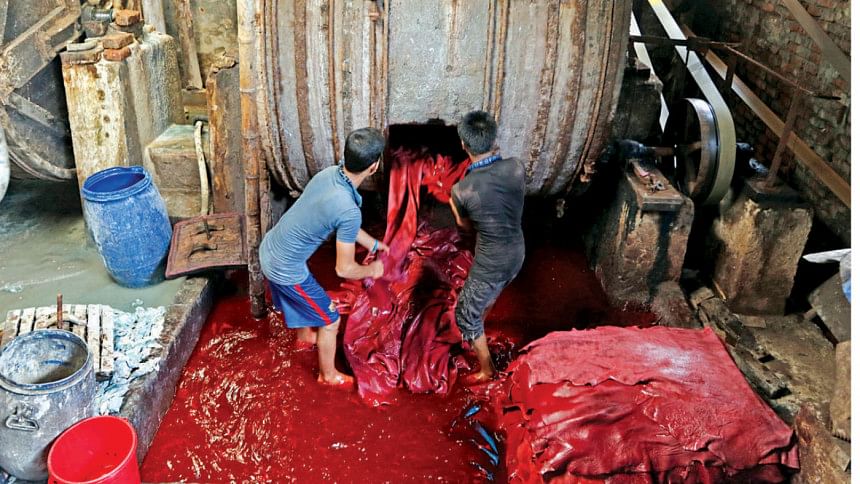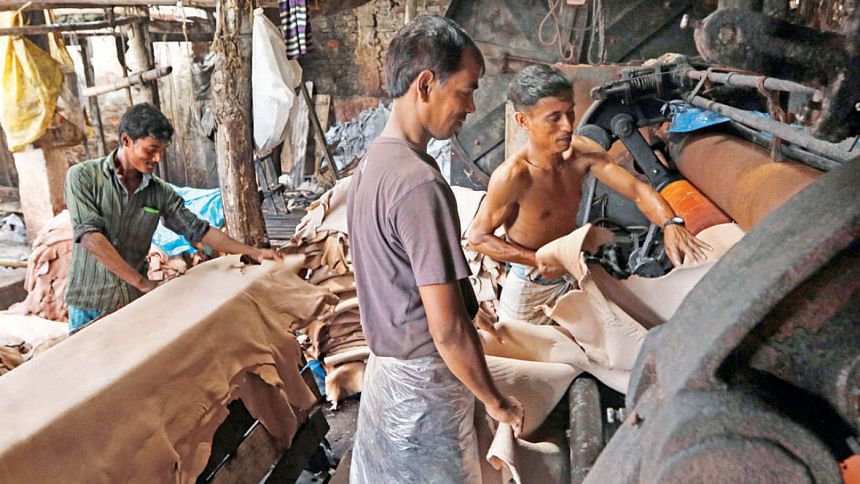Screaming......HAZARIBAGH

Photos: Prabir Das
It is a very small and one of the most neglected parts of Dhaka; not only neglected but also hated. Most people refuse to go there if not forced for their survival. However, this small and clumsy of part of Bangladesh's capital is one of the country's biggest source of foreign export. The place is called Hazaribagh. This 3.58 square kilometre area houses more than 350 tanneries, 95 percent of Bangladesh's tannery industry.
Far from being an industrial complex, Hazaribagh is nothing more than a giant slum of tanneries where more than 15,000 workers are slaving their lives away. These tanneries use lethal toxic chemicals to treat rawhides and throw the toxic wastes out in the open sewers and pits completely untreated. To make matters worse, Hazaribagh is the address of around 200,000 people who are also vulnerable to serious health hazards caused by these toxic wastes.

Mohammed Shajib, a 15 year old boy, is working in a ramshackle tannery shed in Hazaribagh. This shed collects animal hides and treats them to produce a form of leather called 'wet blue'. This tiny shed, housing 15 workers, produces 400 pieces of wet blue daily. To do so, at first, all the collected rawhides are dipped into several pits filled with caustic soda and sodium salts. Shajib's task is to dunk the hides in those open pits to separate flesh and hair from the skin. While treating rawhides in the pits, Shajib's body frequently comes in contact with the corrosive chemicals. "I have been working here for five years. At first I found it very difficult to work here. Still my skin is full of bruises and scars. I have developed some respiratory problems as well," says Shajib.
When asked why he has been doing this job, Shajib gives a surprised look. "If I do not work, who will feed my family? However, I do not feel any pain now. I am used to it." Shajib works here from 8 am to 8 pm and gets only 4000 Taka salary per month. Shajib's co-worker, Abdullah's task is even more dangerous. After treating with soda and salt, all the rawhides are stacked into giant drums. Then sulphuric acid, sulphate salts and some other chemicals are mixed with the hides. Abdullah, with three of his colleagues, are assigned to acid-treat the animal hides. Accidents in this fatally risky task are common. Sulphuric acid is the strongest acid that can eat away any substance. However, these four men of around 20 are handling these toxic chemicals with bare hands.
Abdullah says, "There are many cases of accidents, such as burn injuries. We use the chemicals very carefully for the sake of our own lives." After this phase, in two other huge drums, animal hides are treated with chromium and synthetic dye. Workers like Shajib and Abdullah are treating the hides with dyes and chromium with bare hands. These chromium and synthetic dyes are particularly risky for their carcinogenic properties. However, like Abdullah and Shajib, all these workers are working without any kind of protection.
Abdul Baten, one of the owners of the establishment says, "Our factory is forty years old. These labourers have been working here for generations. Master artisans pass the skills of using chemicals to the young workers." When asked about whether he knows about the labour laws or whether any inspector from the Ministry of Labour and Employment visited the area recently, he replies, "I have not seen this kind of inspector in my lifetime and I am not concerned about these laws."
After observing the entire area of Hazaribagh, it is quite evident that nobody is concerned about any laws. The whole area is full of small tannery sheds like this, which supply the wet blues to all the big industries. After using these toxic chemicals on an industrial scale, the wastes are thrown into open sewers which finally discharge these toxic wastes into one of Dhaka's lifeline-- the Buriganga River. Not a single tannery uses any treatment plant to remove the highly toxic substances such as acids and chromium before discharging the wastes. Md. Mizanur Rahman, the owner of Samota Leather Complex and the treasurer of Bangladesh Tanners Association says, "The Government has ordered us to relocate our factories to the under construction Savar Leather Industrial Park. In that 200 acre estate, a Common Effluent Treatment Plant (CETP) will be installed to refine all the wastewaters."

"Since we will be shifting soon, we are not installing any equipment here. Moreover, the area is too small and none of the factories in Hazaribagh have adequate infrastructure to install individual ETP," he adds. However, discharging such untreated toxic waste is a blatant violation of Bangladesh Environment Conservation Act. However, like Abdul Baten nobody has seen any law enforcer punish any of these factory owners for violating the state law. "We had visited the area and filed cases against some of the owners. Since the government has been working to relocate them, we have stopped our raid as they have managed to get a stay order from the high court" says Dr. Md. Anwar Hossain Howladar, Director, Office for Dhaka Metropolis, Department of Environment.
However, this tannery relocation project was started in 2002 and there is still no signs of completion. Md Sirajul Haider, the project director of Savar Leather Industrial Park says, "Most of our construction work has been completed. The factory owners have also begun constructing their factories. However, we are expecting that we shall be able to install the CETP by December, 2015."
"Completion of this relocation project is very important because without it we cannot take any step to restore the Buriganga River as tanneries are mostly responsible for such intense pollution of the river. We have been told that 70 percent works of the CETP installation has been completed so far. So I am still doubtful about its completion within the next two months", adds Dr. Anwar.
In 1965 when the leather industry started to rise in Bangladesh (then East Pakistan), there were only 30 tanneries in the Hazaribagh area which was not a part of the capital at that time. Now the number has increased up to 350 and now Hazaribagh has become a densely populated residential area. However, residents of Hazaribagh are passing the days in misery. "I can still remember my first day at Hazaribagh. The smell was so disgusting that my wife and my 9 years old daughter started throwing up and then fainted. We all were sick for a whole month. I do not want to stay in this disgusting place, but I have no option," says Asadullah, a bank employee and a resident of Hazaribagh.

Since the factories have been continuously discharging these carcinogenic chemicals untreated, the local residents and also the workers are highly vulnerable to fatal diseases like cancer and other health hazards.
There is no doubt that the tannery industry is one of the most important industries of Bangladesh. Exquisite leather products made by top quality leathers from Bangladesh are appreciated in the luxury marketplaces of Europe and North America. After readymade garments, the leather industry is the most prosperous in Bangladesh. It is also one of the very few, if not the only, industries for which we do not have to import raw materials.
However, the inhumane working condition and intense pollution has brought this industry to the centre of controversy. Recently, Human Rights Watch has published a detailed report on the working condition in Bangladeshi tanneries. Again, two renowned research organisations called Blacksmith Institute and Green Cross Switzerland has declared Hazaribagh the fifth most polluted area in the world.
There is no time to waste, there can be no excuse. Steps must be taken immediately to stop this form of slavery in the tannery industries and to force the factories to stop such pollution. Waiting for relocation cannot be an excuse to continue such exploitation of humans and environment alike, which is pushing hundreds and thousands of lives into the jaws of certain death.
The writer can be contacted at [email protected]
Read More A Deadly Luxury

 For all latest news, follow The Daily Star's Google News channel.
For all latest news, follow The Daily Star's Google News channel. 



Comments